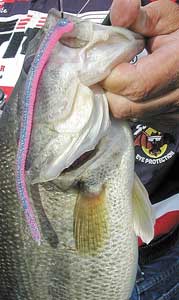
If you’re not sight fishing, you better cover lots of water
April isn’t one of my favorite months, even though a lot of bass fishermen love it. Fish are fairly easy to catch, because they’re in shallow water and are actually hungry.
But to compete in tournaments at the highest level, you’ve just about got to be good at sight-fishing for bedding bass, and that’s just not my strong point. I struggle, not to get bites, but to catch enough big fish to keep up with the guys who will spend an hour to catch a 5-pound fish that’s locked down on a bed.
The best thing for fishermen like me who don’t like to sight-fish is to cover a lot of water. You put your trolling motor down and keep it there. You’re looking to figure out some kind of pattern. In April, they can be in so many different stages. You’ve got ’em locked down on the beds or just moving in, maybe roaming around. You’re trying to find some fish doing something that you can duplicate around the lake.
I do most of my searching with a Zoom Trick Worm and an original Rapala, Nos. 11 or 13. It’s possible that you might catch a fish on a buzzbait, and a Senko is always pretty good.
No matter where you’re fishing — at Buggs Island or High Rock — soft-plastic baits are usually dominant in April, when the bass pull up real shallow. The only thing that changes from lake to lake is what kind of cover you’re fishing. At High Rock, if the water is up, they’ll be in the bushes. At Buggs Island, if the water’s up, they’ll be on gum trees and bushes. Each lake is a little different when it comes to the kind of cover you’ll be fishing, whether or not the water yo-yo’s up and down, and how far back it can get in the bushes.
Most of the bass you catch will be close to pockets. They’ll either be in them already or headed back into them. One thing I like to do is look for fish on the corners of pockets, places they’ll stop and stage on before they move on back in. On those little corners, I’ll fish a No. 11 Rapala.
When I start back in pockets, I’m looking for fish that aren’t up spawning. In a lot of pockets, you’ll find your better fish somewhere close to a little dip or a little crease in the pocket. A lot of times, before they go to the bank, they’ll hold out in the middle of a pocket. You may be sitting in eight feet of water, throwing up into three feet. You’ll find a lot of fish in that deeper water in the middle of the pocket, waiting for things to get right before they head to the bank to look for a place to spawn. That’s another place where you fish a No. 11 Rapala and twitch or jerk it along.
When I feel like the majority of fish have gone to the bank, that’s where I pick up a rod rigged with a Trick Worm. I’ll tie in a swivel about a foot up the line to give it a little weight, and I’ll use a 4/0 VMC wide-gap hook. That gives it a little more weight. If I still can’t fish it fast enough, I’ll put a little split shot or a bullet weight on, and then, I’ll be able to fish it fast enough.
You’re not really sight-fishing; you’re using the Trick Worm as a search bait. If the water is real dirty, you can catch ’em on a spinnerbait, but usually, when the water is really muddy in the spring, they won’t bite too good.
What you’re doing with a Trick Worm is going down the bank, hoping you can find some fish that aren’t locked down on the bed yet, that will come up and hit a worm. I start with the brighter colors, the merthiolates and yellows and whites. Sometimes, if it seems like they’re not hitting those colors, switching over to something more natural — watermelon or green pumpkin — will get them to bite sometimes.
When you’re out with your trolling motor down and on high speed, you’re looking for two things. The first one is an area where fish have just moved up. The second thing is something consistent about where they’re holding. Fish won’t be all spawning at the same time, unless you have a really warm spring, then they might all go at once. But usually, if you’ve got bass locked down in one area of the lake, you can usually find them just moving in somewhere else.
Not every part of a lake will hold a lot of fish. Just keep moving until you find that kind of an area. When you do, you’ll start to catch a few, and you’ll be able to figure out what’s consistent about the places you’re catching them, the baits you’re using and what kind of retrieve is working. And that’s the basis for putting together a good springtime pattern. It’s your only chance to beat those guys who can catch ’em at the peak of the spawn.
David Fritts is a 52-year-old pro bass fisherman from Lexington. He was the 1993 Bassmasters Classic champion, the 1994 BASS Angler of the Year, and winner of the 1997 FLW Tour Championship. His tournament winnings are well into seven figures. He is sponsored by Tums, Ranger boats, Evinrude outboards, Rapala, VMC hooks, Zoom, American RodSmiths and Bass Pro Shops.




Be the first to comment